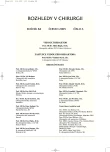The Endovascular Treatment of the Aortic Trauma
Authors:
J. Raupach 1; A. Ferko 2; Miroslav Lojík 1; A. Krajina 1; J. Dominik 3; J. Harrer 3
Authors‘ workplace:
Radiologická klinika, Fakultní nemocnice, Hradec Králové, přednosta prof. MUDr. P. Eliáš, CSc.
1; Katedra Válečné chirurgie, Fakulta vojenského zdravotnictví, Hradec Králové
přednosta doc. MUDr. A. Ferko, CSc.
2; Kardiochirurgická klinika, Fakultní nemocnice, Hradec Králové
přednosta doc. MUDr. J. Harrer, CSc.
3
Published in:
Rozhl. Chir., 2005, roč. 84, č. 6, s. 270-276.
Category:
Monothematic special - Original
Overview
Background:
Traumatic injuries of the thoracic aorta are very frequent during motor vehicle accidents with sudden deceleration. Spiral CT has become the modality of choice for evaluating significant blunt trauma and grading system for aortic injury has been developed. Immediate diagnosis, introduction of antihypertensive therapy and endovascular treatment by means of stentgraft give a better chance for patients with blunt aortic injury.
Aim:
Prospective evaluation of results of endovascularly treated patients with blunt aortic injury.
Materials and Methods:
We prospectively followed patients after endovascular treatment of acute aortic injury. Diagnosis was based on chest x-ray and CT examination. Stentgrafts were placed under fluoroscopic guidance and patients were routinely followed by CT and clinical visit.
Results:
Between December 1999 and September 2004 we endovascularly treated seven patients (6 men, 1 woman, mean age 41.7 years) for blunt aortic injury of the thoracic aorta. Stentgraft was implanted between 5 hours and 6 days (mean 3.2 days) after injury. Seven stentgrafts were implanted in 7 patients in total. One patient died due to failure of endovascular technique for collapsed stentgraft. A new onset of lower legs paraparesis was detected in one patient. Other five patients are regularly followed (3–55 months, mean 30.7 months) without any complications.
Conclusion:
Endoluminal technique can be used successfully in the immediate repair of aortic trauma. At present time in our center, treatment by means of the stentgraft placement is the first line therapy in injured patients. It allows rapid stabilization of aortic trauma and further treatment of other injuries.
Key words:
blunt thoracic aortic injury – antihypertensive therapy – delayed operation, endovascular treatment – stentgraft
Labels
Surgery Orthopaedics Trauma surgeryArticle was published in
Perspectives in Surgery

2005 Issue 6
Most read in this issue
- A Fistule of the Anus in the Crohn‘s Disease
- Internal Fixation of Intracapsular Femoral Neck Fractures
- The Intraabdominally Located Mesh in the Laparotomic Management of Major Hernias
- An Inflammatory Pseudotumor of the Liver Surrounding a Foreign Object
